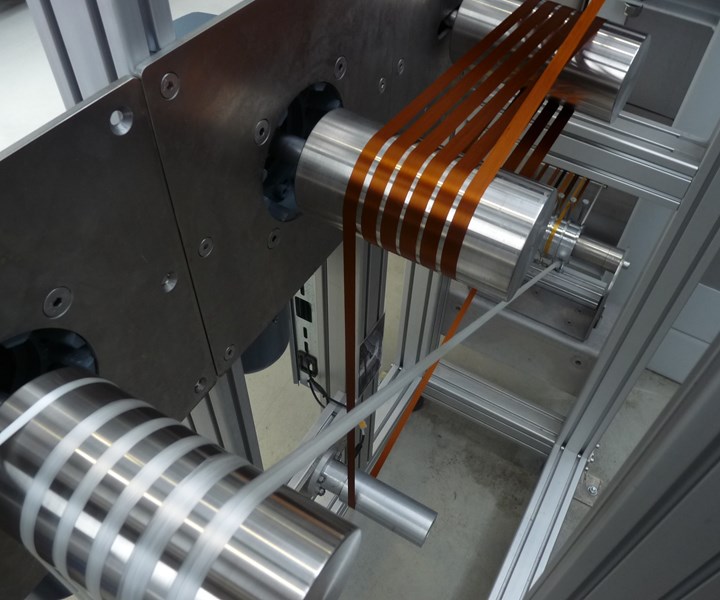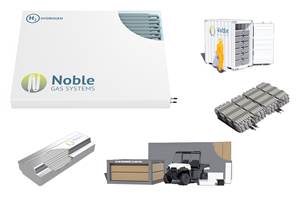ITA RWTH Aachen University launches fiber-coating line, carbon fiber research
The Institut für Textiltechnik of RWTH Aachen University is presenting innovations in glass and carbon fiber production at the joint stand of the Aachen Center for Integrative Lightweight Construction.
Share

Source | ITA
Editor’s note: CompositesWorld received several new product and technology announcements ahead of JEC World 2020, which had been scheduled for March 3-5. Although that exhibition was postponed to May, CW is now publishing the announcements we received. This is one of them.
The Institut für Textiltechnik of RWTH Aachen University (ITA, Aachen, Germany) is presenting innovations in glass and carbon fiber production at the joint stand of the Aachen Center for Integrative Lightweight Construction.
Live demonstrations of multi-fiber coating system
Live at the booth, ITA is demonstrating how its multi-material fiber coating line coats or impregnates rovings made of various materials, producing towpregs, also known as pre-impregnated rovings, from thermoplastics and carbon fibers. Towpregs can be processed by winding or braiding. Examples of use include in drive shafts in the automotive or the aerospace industry.
The system, ITA says, has a wide range of applications and allows a fast output. With a maximum processing temperature of 400°C, it also allows high-temperature thermoplastics to be processed, and quickly tests with a variety of materials on a laboratory scale. The current production speeds are 5 m/min, depending on the material used and the configuration of the system, and ITA says upscaling to industrial scale is possible. The plant can process thermosets and thermoplastics.
With this line, towpregs with circular cross-sections of up to 5 mm in diameter and tape-like geometries of up to 20 mm in width can be produced at a production speed of 5 m/min, depending on the material used and the configuration of the line.
Carbon fiber production research
In addition, ITA is showcasing its production of carbon fibers, one of its core research areas. ITA has a continuous pilot-scale carbon fiber production plant with a production capacity of less than one ton per year. Due to its comparatively small size and the resulting low material input, the plant is ideally suited for the development of new stabilization and carbonization profiles and the testing of new fiber sizings, ITA says.
The current main goal of research in carbon fiber production is to shorten the stabilization time from an initial 50 minutes to approximately 21 minutes. The resulting fibers are at the level of a Toray T700 carbon fiber.
Another approach to reduce the cost of carbon fibers is the use of alternative raw materials such as polyethylene (PE). This can reduce the carbon fiber price by about 50%, ITA says. Due to the existing spinning and sulfonation plants ITA is one of the leading research institutes dealing with the production of cost-effective carbon fibers based on polyolefins.
Textile technology and photonics
Carbon fiber-reinforced (CFRP) components are often assembled by fasteners that are glued into the cured and drilled CFRP component. According to ITA, the integration of the fasteners into a textile preform and an additional curing process to produce the final CFRP component can shorten production process chains and can increase the performance of the joint by at least 50%. This requires high-precision cutouts in the textile for the fasteners.
In the NRW-based project CarboLase, funded by OP.EFRE, laser material processing is integrated for the first time into an automated preforming process. A novelty in the process is the use of the material-friendly ultrashort pulsed laser, which processes the textiles without damaging them thermally.
By combining the technologies in a flexible robot cell, just-in-time production of CFRP components with integrated fasteners is now possible independent of component geometry and batch size. With the new process chain, demonstrators were produced fully automatically. A demonstrator in the form of a B-pillar segment with integrated fasteners is shown in the following figure.
This technology was developed by the Institut für Textiltechnik of RWTH Aachen University, short ITA, in collaboration with its partners AMPHOS GmbH, Kohlhage Fasteners GmbH & Co. KG, LUNOVU Integrated Laser Solutions GmbH and the Fraunhofer Institute for Laser Technology ILT.
High-speed prepreg filament winding
ITA is working with many industries on filament winding technology, including its novel multi-filament winding technology. The main advantage to this method, ITA says, is that many fibers (facility at ITA with 48 fibers) can be wound simultaneously, increasing the processing speed by a factor of 50 and enabling a coverage of 100% in a single pass.
The working speed has been increased further with the development of high quality prepregs through the ZIM project MFWOptiPreg with the company F.A. Kümpers GmbH & Co. KG. The optimized tack (stickness) and fiber breakage, high winding speeds and quality products can be achieved. Filament winding has an advantage of orienting the fibers in the desired direction (0°≤θ<90°).
As an example for quality products, these prepregs have been tested for pressure vessel and torsion shaft manufacturing, ITA says. The developed prepreg is already available in the market.
Related Content
Noble Gas Systems 350-bar conformable pressure vessels pass HGV2 standard tests
Conformable tanks with new materials pass technical tests for hydrogen storage, to compete with Type IV pressure vessels using CFRP.
Read MoreCo-molding SMC with braided glass fiber demonstrates truck bed potential
Prepreg co-molding compound by IDI Composites International and A&P Technology enables new geometries and levels of strength and resiliency for automotive, mobility.
Read MoreCorebon, Composite Braiding partner to enhance TPC manufacturing
Collaboration aims to overcome production limitations with tubular thermoplastic composites (TPC) by using induction-heated tooling and high-quality commingled braids.
Read MoreRead Next
“Structured air” TPS safeguards composite structures
Powered by an 85% air/15% pure polyimide aerogel, Blueshift’s novel material system protects structures during transient thermal events from -200°C to beyond 2400°C for rockets, battery boxes and more.
Read MoreAll-recycled, needle-punched nonwoven CFRP slashes carbon footprint of Formula 2 seat
Dallara and Tenowo collaborate to produce a race-ready Formula 2 seat using recycled carbon fiber, reducing CO2 emissions by 97.5% compared to virgin materials.
Read MorePlant tour: Daher Shap’in TechCenter and composites production plant, Saint-Aignan-de-Grandlieu, France
Co-located R&D and production advance OOA thermosets, thermoplastics, welding, recycling and digital technologies for faster processing and certification of lighter, more sustainable composites.
Read More
.jpg;width=70;height=70;mode=crop)

















.jpg;maxWidth=300;quality=90)






